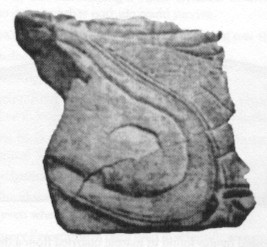The Mesozoic Era is one of the major divisions
of geological history, following the Paleozoic era and preceding
the Cenozoic era. The Mesozoic era, which lasted from
approximately 240 million to 65 million years ago, may be
characterized as the Age of Reptiles because their greatest
development occurred during this era. The first birds and
mammals and the first flowering plants also appeared at this
time. The Mesozoic era is divided into three time periods: the
Triassic, Jurassic, and Cretaceous.
As we move back into time we enter a period in the Mesozoic Era
that began with the first dinosaurs appearing on the earth and
ending with the development of flowering plants. Humans wouldn't
evolve for at least another 136 million years. Yet the
scientific finds below suggest proof that advanced civilizations
were visiting Earth's past and walking at a time when dinosaurs
roamed the planet.
Cretaceous Period
 |
Metallic Tube at Saint-Jean de Livet, France over 65
million years old.
Y. Druet and H. Salfati announced in 1968 the discovery
of semi-ovoid metallic tubes of identical shape but
varying size in Cretaceous chalk. The chalk bed, exposed
in a quarry at Saint-Jean de Livet, France, is estimated
to be least 65 million years old. Having considered and
eliminated several hypotheses, Druet and Salfati
concluded that intelligent beings had lived 65 million
years ago. Who brought and left behind these metallic
tubes in France more than 65 million years before the
first human being would appear? |
Triassic Period
 |
Shoe Sole from Nevada, dated at 213 - 248 million
years ago.
On October 8, 1922, the American Weekly section of the
New York Sunday American ran a prominent feature titled
"Mystery of the Petrified 'Shoe Sole,' by Dr. W. H.
Ballou. Ballou wrote: "Some time ago, while he was
prospecting for fossils in Nevada, John T. Reid, a
distinguished mining engineer and geologist, stopped
suddenly and looked down in utter bewilderment and
amazement at a rock near his feet. For there, a part of
the rock itself, was what seemed to be a human
footprint! Closer inspection showed that it was not a
mark of a naked foot, but was, apparently, a shoe sole
which had been turned into stone. The forepart was
missing. But there was the outline of at least
two-thirds of it, and around this outline ran a
well-defined sewn thread which had, it appeared,
attached the welt to the sole. Further on was another
line of sewing, and in the center, where the foot would
have rested had the object really been a shoe sole,
there was an indentation, exactly such as would have
been made by the bone of the heel rubbing upon and
wearing down the material of which the sole had been
made. Reid got hold of a microphotographer and an
analytical chemist of the Rockefeller Institute, who
made photos and analyses of the specimen. The analyses
removed any doubt of the shoe sole having been subjected
to Triassic fossilization.... The microphoto
magnifications are twenty times larger than the specimen
itself, showing the minutest detail of thread twist and
warp, proving conclusively that the shoe sole is not a
resemblance, but is strictly the handiwork of man. Even
to the naked eye the threads can be seen distinctly,
along with the definitely symmetrical outlines of the
shoe sole. Inside this rim and running parallel to it is
a line which appears to be regularly perforated as if
for stitches. The Triassic rock bearing the fossil shoe
sole is now recognized as being dated at 213 - 248
million years old. An obviously modern shoe, complete
with stitching, and etched in time in ancient Triassic
rock. What modern visitor was walking in our distant
past more than 210 million years ago before the age of
the dinosaurs? |
Source: FORBIDDEN
ARCHEOLOGY, The Hidden History of the Human Race, by Michael A.
Cremo and Richard L. Thompson, published by Bhaktivedanta Book
Publishing, Inc. There is no better source for additional
information and study on this subject than Forbidden Archeology.
This remarkable collection of research and analysis is an
important work of thorough-going scholarship and intellectual
adventure.
|
|
|



